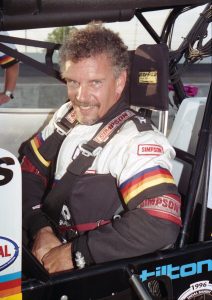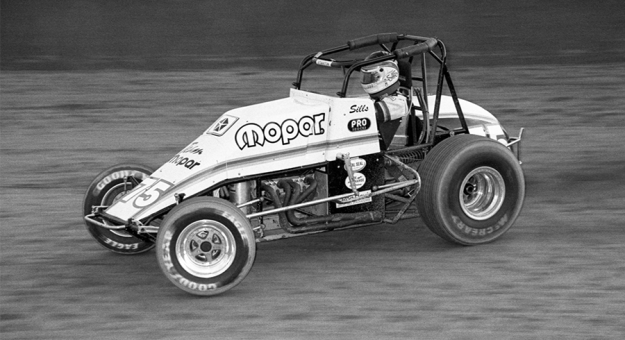USAC NOS Energy Drink National Midget Series participants know California’s Placerville Speedway is the site for the lucrative Hangtown 100.
However, for some any mention of the Northern California town immediately produces memories of National Sprint Car and USAC Hall of Famer Jimmy Sills.
Sills enjoyed a remarkably lengthy career that began in 1973 at tough places like West Capital Raceway in Sacramento. Soon Sills was a road warrior, so chances to race near his home became a luxury.
By 1996, Sills was recognized as among the best at his craft. Like all who take on the toughest competition Sills had suffered dry spells, but as this season began to wind down, he enjoyed one of the most productive stretches ever.
Sills, a two-time Silver Crown champion sought his third title in Gary Stanton’s Mopar powered craft. The duo certainly hoped for good results, but both knew there would be teething problems as they developed the engine.

When he took the checkered flag at Richmond Int’l Raceway in mid-June it was the first win for the powerplant. Two years of work had paid off. They weren’t done. In late September, Sills and Stanton struck again with a USAC sprint car triumph during the 4-Crown Nationals at Eldora Speedway.
As the days grew shorter, the biggest races on Jimmy’s slate occurred in his home state. On Oct. 5, he climbed into Dave Calderwood’s midget and held off red-hot Billy Boat to win the USAC Western States date at Kings Speedway in Hanford. Less than a week passed before Sills was back with Calderwood at Placerville Speedway.
What unfolded was one of the most unusual races in USAC history. The bottom line was that just 12 cars had signed in at the quarter-mile dirt oval. Because the Silver Crown series would race the next day at Cal-Expo in Sacramento, USAC media head Dick Jordan made the trip from Indiana.
Jordan had experienced this kind of thing before and together with on-site officials concocted a program of two heats, two consolation races, a semi-feature and a 30-lap finale. In what proved to be an entertaining affair, Sills held off Shane Scully for the victory.
Heading into the penultimate round for the 1996 Silver Crown season Sills held a 20-point lead over Kenny Irwin Jr. It looked promising for Sills when he claimed the pole. He led the first 31 laps. Then disaster struck.
“I got tangled with a lapper,” he said. “I was going around him and all of a sudden, he came down across my front end. It snapped the radius rod and folded the front end up.”
It looked like his championship hopes were dashed.
Eight days later, the Silver Crown season ended at the strikingly beautiful Del Mar Fairgrounds. It was the first appearance of the big cars since the great Rex Mays perished at the facility in November 1949. Esthetics aside, the racing surface left much to be desired.
“It had some soft sand going in to turn three and you went over a couple of humps, I guess you would call them dunes,” Sills said. “When you turned in there it was just thick sand. It was crazy.”
Irwin entered the event as the point leader and he was safely in position to win the title when the white flag was displayed. Heading into turn three he blew a tire and collided with Ryan Newman. Sills pulled into victory lane satisfied with his day’s work when someone whispered that he may have just won his unprecedented third Silver Crown title. He had no idea that Irwin had failed to finish.
Owner Gary Stanton was equally befuddled thinking that Irwin had just rolled to a stop on a cool-down lap. When announcer Bruce Flanders relayed the news, Sill thrust both arms in the air. Meanwhile a dejected Irwin walked directly out of the facility.
His late season surge was not over. In 1996, Perris Auto Speedway staged the inaugural Oval Nationals. Behind the wheel of Don Berry’s car Sills held off future Hall of Fame drivers Ron Shuman, Richard Griffin, and Tony Elliott to take the win.
Sills acquired many nicknames over the years but the moniker “The Professor” was the result of his long-standing driving school held at Marysville Raceway. While most took the opportunity to get a feel for racing a sprint car, a midget was available for use. When it came to novices, Sills had strong advice.
“People always thought they should start off in the midget and I said, ‘Oh no, that thing is way harder to drive than a sprint car because they react so fast, and they are more tippy and just more of a handful.’ That is why real racers like running midgets because the driver is more a part of the operation,” Sills said. “I would also tell people they are really fun to race but they are more pain for less pay. You could get hurt easier in them, and they don’t pay nearly as much.”
Which brings us back to the Hangtown 100. Sills did not race at Placerville often, but he had enough experience to develop a bit of a book on the track.
“I remember racing there way back when the track was really flat. It wasn’t fun at all,” he said. “After it changed, I raced there about once a year usually in a midget. The trick is to be able to run that little narrow cushion. It gets really narrow in one and two but you have got to stay on it and get on it early in the corner so you can get back in the throttle and ride the rim.
“In three and four the cushion gets really deep because it is shaded from the sun the last part of the day,” Sills noted. “It always stays heavier there, and you get a deep cushion. I always found if I could get right up next to that dirt bank on the back straightway and open my entrance into three and four then I could run that curb a lot better rather than trying to slide up to it in the middle of a corner.”
Sills feels the track is well suited for midget racing.
“Any track you go to with a midget seems automatically wider and racier,” he said. “That’s why they always put on good races especially now with all these kids sliding each other every corner.”
Sills remains in racing shape and he keeps sharp by engaging in no-holds-barred kart racing on his own property and taking dirt bikes into the most remote and treacherous terrain in the region. Maybe it’s time to end another retirement and climb back in a midget. He doesn’t think so.
“It looks like fun from the grandstands” he said with a laugh, “and I have run races like that where you are sliding each other in every corner. Back in my younger days I would have just loved it. As I got older, I started liking slicker tracks and a little less action.”
